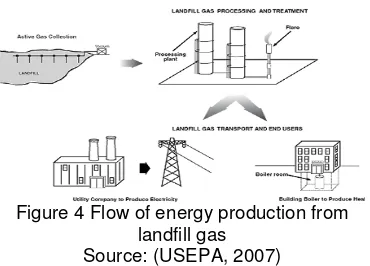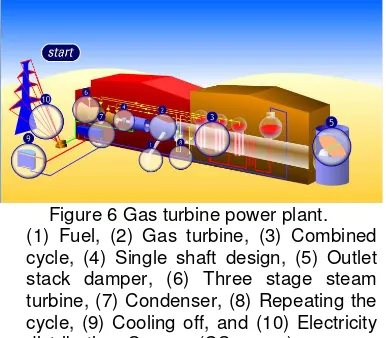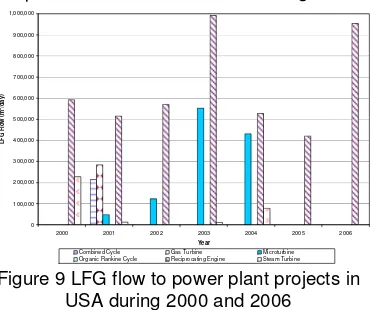*) Program Studi Teknik Lingkungan FT Undip
Jl. Prof. H. Sudarto, SH Tembalang Semarang 9
ABSTRACT
Energy from renewables has been sought to replace current fossil fuel energy generation. Landfill gas has great potential to generate power since it contains methane 40 to 60%. Utilizing an enhanced landfill gas as fuel for power generator is also beneficial to reduce greenhouse gas emission from landfill otherwise it will escape to the atmosphere. Current technology in power generation from landfill gas includes organic rankine cycle (ORC) and stirling cycle engine (SCE) to add the traditional reciprocating internal combustion engine (ICE) and gas turbine (GT). The state-of-the-art power generation technologies have been developed and demonstrated in the US whereas in Australia, landfill gas power plant remains with the conventional ones; reciprocating engine and gas turbine.
Keywords: landfill gas, bioreactor landfill, electricity generation, engine
INTRODUCTION
World energy consumption has doubling since 1980 to account for 444 exajoules in
2003 and is projected to increase
significantly until 2030. Australia also showed an increase in electricity consumption with 54 % in 14 years to accounting for 224.89 TWh in 2004 (IEA, 2007, UIC, 2006). Interestingly, most of the production, about 79%, is using
coal. The future trend of electricity
consumption in Australia is projected to rise 35% by 2020 (UIC, 2006). Facing the increasing future demand of electricity and decreasing of fossil fuel, thus a renewable fuel should be taken into granted as a solution for supplying more environment friendly power plant.
Figure 1 World marketed energy consumption
Source: (EIA, 2006)
Australia has introduced several renewable resources for power plant, including natural gas, hydro, solar, and biomass. It contributed 20% of electricity production in 2004.
Another emerging renewable energy source is biogas derived from waste. Solid waste decomposition produces gas comprising methane and carbon dioxide. Methane has high energy content which can be exploited to generate electricity. Regarding electricity generation from landfill gas, USA is leading
with innovations on the generators
technology and gas production improvement. This paper will discuss the potential of methane produced in landfill as alternative renewable energy fuel. Innovations on electricity generation from landfill gas is described and followed by challenges to
implement new technologies. An
implementation of landfill gas for power plant in Australia and USA is then discussed.
METHANE PRODUCTION IN LANDFILL SYSTEM
LANDFILL GAS PRODUCTION
Decomposition process of organic waste in landfill results in waste settling and by-products included leachate and landfill gas (LFG). LFG mainly consists of methane (40-60%) and the rest comprises carbon dioxide and trace gases (Reinhart and Townsend, 1998). Gas production in landfill occurs in four phases (Figure 2). Phase 1 is a hydrolysis phase where organic substrate is break down by aerobic bacteria to produce carbon dioxide. In phase 2 or acetogenesis phase, oxygen is depleted and aerobic
10
compound and produce more CO2 and
hydrogen. Phase 3 is a methanogenesis where anaerobic bacteria is growing and producing lots of methane. Phase 4 is the early maturation stage where gas production remains steady. Composition of landfill gas produced is 40% to 60% methane and 40% to 60% carbon dioxide (ATSDR, 2001). These gases will be continuously produced for 20 years and will cease when landfill is at maturation phase.
Figure 2 Landfill gas production phases Source: (USEPA, 1997)
LFG is then collected through passive or active system. Passive system involves wells similar to groundwater well where gas is drawn to the well because of different
pressure between landfill and the
atmosphere. Active system incorporated a vacuum on the well to create greater potential in the wells and extract gas from landfill (Figure 3). The extracted gas is then purified by gas scrubber to remove carbon dioxide, to produce LFG.
Figure 3 Active gas collection system in landfill
Source: (ATSDR)
The total amount of LFG generated in the current year (LFGt) is estimated using:
(
kc kt)
municipal solid waste (MSW)
R kg/yr Filling rate
t number of years Time since landfill opened c number of years Time since landfill closure k 1/years Annual rate of LFG
generation
Source: (AGO, 1997)
The value of c is zero if the landfill is still accepting waste. The value of e is based on
the Napierian or natural logarithm
(approximately 2.718). Lo is estimated from
waste composition and degradable organic content which values are provided in Table 1. According to Vogt, Peyser, and Peterson (1996), total LFG yield per kilogram MSW is 0.17 m3/kg (AGO, 1997).
Table 1 Amount of carbon expressed in the percentage of fresh weight
Material Percentage
Paper and
WHY USING LFG FOR ELECTRICITY GENERATION
The benefit from using methane as biogas to generate electricity can be calculated based
on CO2 equivalent emission. For instance,
for 1 MW gas generator needs around 700 m3 of 50% methane per hour (REM and
RMIT, 1999) and the amount of CO2
conserved from the atmosphere:
2 save greenhouse gases of approximately
11 11
LFG collected at the landfill site is used for electricity generation. The gas is pumped out and then underwent pretreatment to remove
CO2 and yield CH4 (Figure 4). LFG collecting
and processing plant requires a flare station to burn the excessive methane production. Energy from LFG can be transformed into cogeneration system or supplied to power plant and natural gas pipeline.
Figure 4 Flow of energy production from landfill gas
Source: (USEPA, 2007)
LFG power generation engine is varied and each of them has benefits and drawbacks. Brief reviews of some traditional and current technologies are depicted in the following.
RECIPROCATING INTERNAL COMBUSTION ENGINE (ICE)
Table 2 Characteristics of LFG power plant engines
Characteristics Unit ICE GT ORC SCE
Electric efficiency 33% 28% 18% 38.58% Fuel consumption kJ/kWh 10972 12872 19202 9390 Emissions:
NOx ( g/kJ) 56.6 15 16 3.11
CO ( g/kJ) 56.6 19 18.9 15
Source: (Bove and Lunghi, 2006)
Figure 5 Reciprocating engine Source: (USEPA, 2007)
electricity from LFG. Currently it is the most utilized technology for power generation from LFG considering its compact form which is flexible to move from a landfill to another. The acceptable revenue of 1 to 3 MW facility along with reasonable capital cost and low in economic risk are the benefits of this machine (Bove and Lunghi, 2006). However the limited capacity of power plant that can provide sufficient revenue will hold back the development of higher capacity to support increasing demand on energy supply. Moreover air pollution from this power plant is higher compared to the other technologies (Table 2). In case of Australia, reciprocating engine has been used in most all LFG power plants and one of it is in Victoria, the Brooklyn Landfill Gas Project of 1 MW (ABCSE, 2007).
GAS TURBINE (GT)
Gas turbine is usually applied for combined
heat and power
(CHP) operations. The operation includes a heat recovery from a simple cycle gas turbine exhaust to produce thermal energy in the form of steam or hot water. The
Swanbank 5 MW power station in
Queensland is an example of LFG power plant that uses gas turbine (Figure 6). Gas turbine engine can vary from 1 to 5 MW for typical LFG power generation.
12
Figure 6 Gas turbine power plant. (1) Fuel, (2) Gas turbine, (3) Combined cycle, (4) Single shaft design, (5) Outlet stack damper, (6) Three stage steam turbine, (7) Condenser, (8) Repeating the cycle, (9) Cooling off, and (10) Electricity distribution. Source: (CSenergy)
ORGANIC RANKINE CYCLE (ORC)
Organic rankine cycle (ORC) is a closed cycle process of converting thermal energy produced by flare burning in landfill to mechanical energy by utilizing organic fluid (USCCTP, 2005). The ORC operations for converting LFG require no alteration of plant layout of the ORC using geothermal energy. Energy input is the main operating parameter of the system, wherein LFG can be used without concern of fuel type. As the system is still under research and development process and costly, the ORC demonstration is still infrequently implemented.
From recent findings, the performance of this system is incomparable to the conventional ones, ICE and GT. The efficiency of system is much lower and it emits more pollutants.
Figure 7 Organic Rankine Cycle Engine Source: (USEPA, 2007)
STIRLING CYCLE ENGINE (SCE)
Stirling cycle engine is a closed-cycle hot air engine. The advantage of using this system for electricity generation from LFG is high
heat capacity and power densities of the external combustion engine. On the other hand, high content is a drawback of the system along with limited size of engine and rare demonstration projects.
Prior research has found that this system
emits low emissions of NOx and carbon
monoxide (CO) in comparison with other systems (Table 2). It low in fuel consumption and high efficiency are the main advantages from this system. Further development and large scale demonstration should be done to test the performance of this system.
Figure 8 Stirling “external combustion” engine
Source: (USEPA, 2007)
LFG POWER PLANT CHALLENGES
IMPLEMENTATION OF LFG FOR
ELECTRICITY GENERATION
Landfill gas in form of methane can supplement fossil fuel function to fuel power
plant. It mitigates greenhouse gases
emission in two ways, alleviating CO2
emission from fossil fuel combustion and
exploiting CH4 from landfill for energy
production. The development of landfill gas power generation in USA is faster compared to Australia. Figure 9 illustrates LFG flow power plant projects in USA over the period 2000 to 2006. The reciprocating engine, gas turbine, steam turbine, and combined cycle engine have predominant the past century technology for electricity generation. From 2000 to 2006, the conventional technologies contributed at most. Established in 1982, Vermont Energy Recovery was the first landfill gas power plant that utilizes reciprocating engine to produce 500 kWe.
Interestingly, the 21st century is signed with
13 13
innovation, the flow of LFG is very low compared other established technologies.
0
2000 2001 2002 2003 2004 2005 2006 Year
Combined Cycle Gas Turbine Microturbine Organic Rankine Cycle Reciprocating Engine Steam Turbine
Figure 9 LFG flow to power plant projects in USA during 2000 and 2006
In case of Australia, LFG power plant in 1997 was summing up for 80 MW landfill gas power plants (Table 3). It has been increased to 97 MW in 1999, 100 MW in 2003, and 105 MW in 2005 (ABCSE, 2007, AGO, 2005, REM and RMIT, 1999). All the landfill gas power plant in Australia is still using reciprocating engine and gas turbine. Current technology developed in USA has not adopted yet in Australia. This is because the
policy of the Australian government
regarding renewable energy has been focused on hydro power. More than 90% of renewable energy generated in Australia was coming from hydro power while landfill gas was only 2.5% of the total renewable energy (Table 4). Similar figure was also reflected in the sales of energy.
Table 3 Landfill gas generation plants in Australia
Power plant Capacity (MW)
Belrose, NSW 4.0
Lucas Heights, Menai, NSW 3.0 Lucas Heights WMC, NSW 8.0
Perth, WA 13.2
Springvale, Vic 8.0
Sunshine, Vic 7.7
Tea Tree Gully, SA 3.0
Wingfield I, SA 5.0
Wingfield II, SA 2.0
TOTAL 80.0
Source: (REM and RMIT, 1999)
Primary Fuel Generation (GWh) Sales ($M)*
Hydro 15,765 581
Bagasse 388 18
Landfill Gas 416 17
Sewage Gas 26 2
Wind 168 12
TOTAL 16,763 630
Source: (ABCSE, 2007)
ENHANCING LFG PRODUCTION
A bioreactor landfill, as illustrated in Figure 10, is a system of rapid degradation of organic waste by adding liquid which enhance nutrient supply for microbial
processes (USEPA, 2006). The fast
degradation process will bring forward the LFG production. Figure 9 is illustrating an accelerated LFG production in bioreactor landfill where methane occurs faster due to rapid hydrolysis and oxygen consumption by microorganism. According to EPA (2006), bioreactor system is not only enhanced the process but also increase the yield of gas. Further research should be conducted to predict bioreactor landfill gas production phases.
(a) (b)
Figure 10 Leachate recirculation and LFG extraction in bioreactor landfill at (a) active
site and (b) after closure Source: (TiTreeBioenergy)
14
The application of bioreactor landfill has both
technical and non-technical barriers.
Technical barrier mainly result from
additional leachate into the site. A rise of leachate load might increase pressure on base liner and likely to damage the geomembrane. Leachate leakage from bioreactor landfill has higher potential of groundwater pollution as recirculation aims to enrich nutrient in the waste. Another obstacle is to control gas pressure in the landfill since the production rises rapidly. High pressure is likely to trigger a fire or an explosion in landfill.
Non-technical barrier of implementing
bioreactor landfill will come from community while locating an area for bioreactor landfill. Because bioreactor landfill requires a meticulous design of layer and liner, a conventional-existed landfill may not be suitable for bioreactor landfill. Therefore operator needs to find a site that complies to all environment, economic and social aspects.
NON-TECHNICAL CALLENGES
The cost of electricity from LFG AU$55 to $90 per MWh is still expensive vis-à-vis cost of coal or natural gas power AU$30 to $60 per MWh (AGO, 2005), which may suppress investment in LFG technology and get less interest from consumers. Nonetheless by increasing community awareness of the life cycle cost, the cost of renewable energy might be considered cheaper than non-renewable one.
The Australian government has introduced the Mandatory Renewable Energy Target (MRET) that directives a rise of renewable energy supply in Australia energy market with target of additional 9,500 GWh per annum by 2010. In addition, the government also provide funding to attract more research and development and demonstration of such new innovations. The fundings comprise $50 million Renewable Energy Commercialisation
Programme (RECP), $205 million
Renewable Remote Power Generation
Programme (RRPGP), and $20 million Renewable Energy Equity Fund (REEF). A Greenhouse Friendly Project managed by the Australian government for balancing the greenhouse gas emissions from industry is stimulating a joint venture between LFG
operators and fossil fuel power plant operators to reduce overall greenhouse gas emissions. The Greenhouse Friendly Project is similar to Landfill Methane Outreach Programme (LMOP) conducted by US Environment Protection Agency. The USEPA is again one step further regarding landfill gas power generation as it has supported many demonstrative project of new generator
through funding and research and
development programs.
The regulations might increase investment in LFG energy since it is a qualified energy according to MRET. The conventional LFG power generator systems have proven a good performance, however, the state-of-the-art should demonstrate the capability that offers an affordable-high quality energy
supply and improve the environment
performance.
CONCLUSION
Landfill gas is a viable solution to substitute fossil fuel for electricity generation that provides a sustainable energy. It is not only reducing greenhouse gas emissions from fossil fuel power plant but also alleviating fugitive landfill gas. Gas emission from landfill is a valuable waste that should be
recovered particularly concerning the
methane energy content.
Electricity generation from landfill gas has evolved especially improvement on new generator technologies. Power generator innovations have improved the efficiency and
environment performance. The new
technology, however, still needs to prove the capability to supply energy for a sustainable world.
Regulations and set of government funding have been introduced to enhance power generation from renewable sources wherein LFG is an eligible source of energy according
to both Australia and USA. Both
governments have supported the
development of renewable energy; however the Australian government needs to give more attention to the landfill gas power
generation and learning from USA
15 15
generation should be conducted to improve the performance of green power in environmental, social, and economic sectors.
REFERENCES
ABCSE (2007) Australian Business Council for Sustainable Energy,
http://www.bcse.org.au/default.asp?i d=257
AGO (1997) Methane capture and use -
Waste management workbook,
Department of the Environment and Water Resources
Australian Greenhouse Office.
AGO (2005) Australia Greenhouse Office, Department of Environment and Heritage,
http://www.methanetomarkets.org/re sources/landfills/docs/australia_lf_pr ofile.pdf
ATSDR
http://www.atsdr.cdc.gov/HAC/landfill /html/images/fig5_2.gif
ATSDR (2001) Department of Health and Human Services
Agency for Toxic Substances and Disease Registry
Division of Health Assessment and Consultation,
http://www.atsdr.cdc.gov/HAC/landfill /html/toc.html
Bove, R. and Lunghi, P. (2006) Energy
Conversion and Management, 1391-1401http://www.sciencedirect.com/sc ience/article/B6V2P-4H8FPGH-3/2/d6b86e0e8e593af0d0885269aab d9f7d
CSenergy
http://www.csenergy.com.au/learning _centre/how_elec_is_made.asp EIA (2006) Energy Information
Administration,
http://www.eia.doe.gov/oiaf/ieo/figure _7.html
IEA (2007) International Energy Agency, http://www.iea.org/Textbase/stats/ind icators.asp?COUNTRY_CODE=AU Reinhart, D. R. and Townsend, T. G. (1998)
Landfill bioreactor design and operation, CRC Press LLC.
REM and RMIT (1999) 2% Renewables
target in power supplies
Potential for Australiancapacity to expand to meet the target, Redding Energy Management Pty Ltd.
dex.php?categoryid=20
UIC (2006) Uranium information centre, http://www.uic.com.au/nip37.htm USCCTP (2005) United State Climate
Change Technology Program, http://www.climatetechnology.gov/libr ary/2005/tech-options/tor2005-413.pdf
USEPA (1997)
http://www.atsdr.cdc.gov/HAC/landfill /html/images/fig2_1.gif
USEPA (2006) United State Environment Protection Agency,
http://www.epa.gov/epaoswer/non-hw/muncpl/landfill/bioreactors.htm USEPA (2007) United State Environment
Protection Agency,



